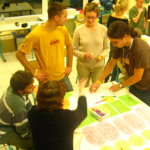Metaplan
What is Metaplan about ?
The method can be used for facilitating large information markets (50-200 people) or conferences, but can be used for facilitating small management teams as well.
Metaplan can be used in the following areas:
Creating, collecting, gathering, structuring, storing, visualizing of ideas.
Introducing people in seminars.
Interconnectedness analysis.
Cause analysis.
Setting priorities.
Building momentum or support for a change initiative.
Evaluation.
Audience
Is participant experience relevant for Metaplan ?


Requirements
Run Through
Rules for using Metaplan
There are some basic rules for writing on cards, which should be communicated to participants at the start of a session:
• Write very clearly in black marker, using capitals if necessary.
• Only one item of information on each card.
• Three or four lines of writing per card. A short phrase should be sufficient. Two or three words are rarely enough to describe a fact sufficiently clearly, while five or more lines cannot be easily read from a distance.
Some basic rules for facilitators are:
• Use cards of one colour for each category of information. Place piles of cards within easy reach of all participants.
• Treat all cards in the same way, making no distinctions unless the group itself wishes to. The facilitator should never give his or her views on the content of a card.
• If the group agrees that a text is not clear; ask that the card be rewritten, but only after the new formulation has been agreed upon by the group.
• Never remove or reject a card, unless the group has decided that it is no longer needed.
• Place the cards on the chart so that the information can be clearly seen. Never overlap cards so part of the text cannot be read.
• Never stick down cards permanently until it is absolutely sure that the chart has been completed.
Material for
Standard oval, cloud-shaped and rectangular cards of various colors
Felttip pens
Gluesticks
Paper in A2 format - one sheet for each group
Display boards
A series of standard presentation get-togethers
Some facilitators use only flip charts for recording ideas, but this constrains the classification and assessment of ideas and information, since they are fixed on the page in the order they are written. The “Metaplan” method of visualisation, whose basic materials are coloured cards, marker pens, and sheets of A2 paper, is a much more flexible and effective technique for participatory workshops, and provides a much better support of analysis and decision-making involving complex information. The coloured cards are used for recording ideas and information. They can be arranged and rearranged on the large charts of A2 paper. They demand that ideas and information be expressed in a concise and clear way. They are colourful, and the colours can be used to identify particular categories of information (e.g. yellow for obstacles, green for objectives, etc.). Information cannot be hidden or ignored if it is on a card on the chart. Because every idea is recorded, the process is very transparent. The cards also foster logical analysis, illustrating distinctions and similarities, and making comparisons possible. Basic cards are oblong in shape (20,5 x 9,5 cm); these are used for recording information during participatory sessions. Some facilitators use only these cards. Oval, circular or hexagonal cards can be used to create diagrams and images or for title cards. They are not necessary, but are a nice addition to a facilitator's tool kit as well as to the final product.
Metaplan can be run without any special materials: coloured cards are attractive but simple post-it notes (12 x 6cm) are good enough.

ERASMUS +
Co-funded by the Erasmus+ Program of the European Union. Find more information about the program and its goals here: https://erasmus-plus.ec.europa.eu/.
Views and opinions expressed are however those of the author(s) only and do not necessarily reflect those of the European Union or the European Education and Culture Executive Agency (EACEA). Neither the European Union nor EACEA can be held responsible for them.

Creative Commons license:
CC-BY-SA You are free to distribute, remix, adapt, and build upon the material in any medium or format, even for commercial purposes with mention of the source: Transformation Hosts International, www. hostingtransformation.eu. If you remix, adapt, or build upon the material, you must license the modified material under identical terms.


